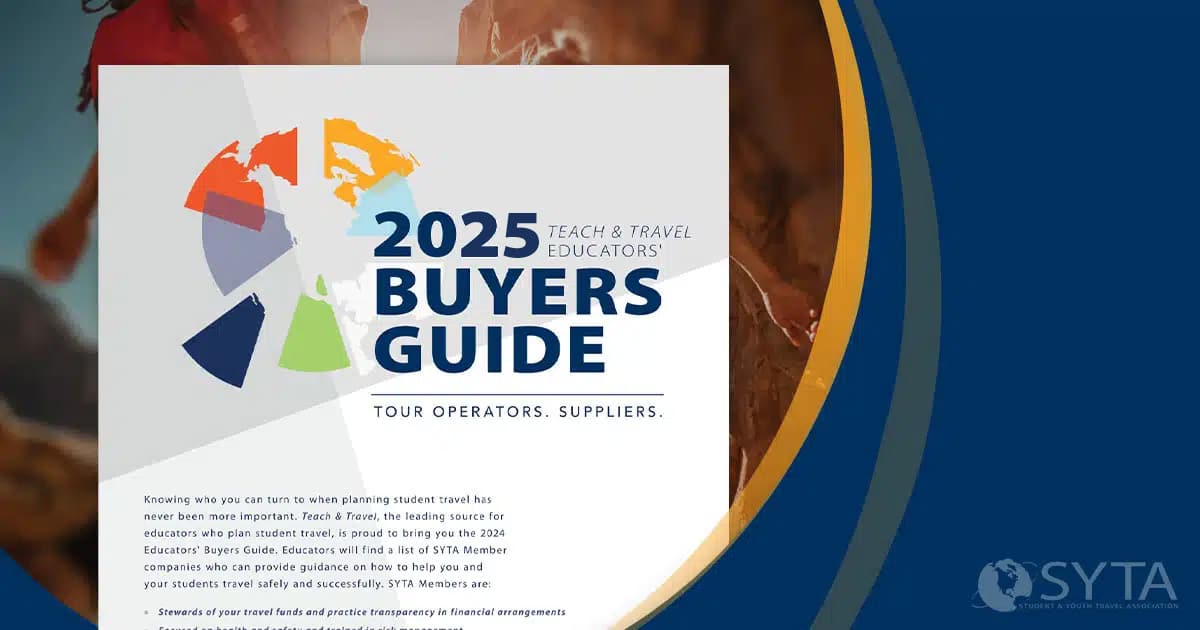Traveling brings subjects to life, broadens students’ horizons and provides opportunities for students to gain real-world experiences that can’t be taught in a classroom. As educators, we are well-aware that traveling opens minds to different cultures and strengthens students’ knowledge of the world.
However, how informed are we about other benefits that student travel experiences provide? What can teachers do on school trips to cultivate students to be accepting of not only themselves, but their peers?
World Strides, a student travel company, created a list of benefits that students gain when they travel. In their list, they highlighted assets above and beyond the most common one, heightening students’ awareness of the world. To me, these other advantages are at the forefront of what educators want for their students. They want students to (1) develop compassion (2) make new friends (3) build confidence (4) gain networking skills (5) see others perspectives (6) develop grit (7) experience growth and independence and (8) explore individuality.
Teachers want youth to be compassionate and appreciate who they are, but more importantly, value others. Often, when students travel together, they break into groups, cliques. Often, the cliques were already in place before the journey began. In some instances, the group is composed of a variety of students from various schools who are not familiar with each other. Once the tour begins, groups immediately begin to form. These cliques, people with shared interests, are often not friendly with others.
Educators must be observant and break up these cliques as soon as possible to avoid negative interactions. This can occur by mixing up the students through hotel room assignments, bus seating assignments, assigned meal tables and subdivision of smaller groups. Educators should encourage students to show compassion to members of the student group as well as those they meet along the way. Instead of mocking a fellow student for his mismatched clothing, lack of social skills or loneliness, he should empathize and assist the student. Showing compassion and suffering together teaches both students valuable lessons and helps students break down barriers and open new channels of lifelong friends.
These new relationships—which may have never been established if the group not been traveling together—develop because of a shared experience. Before you know it, cliques are busted, students are more open with each other and want to offer a helping hand to their new friends, and the journey is memorable in many ways.
Through interactions with group members, tour guides and those they meet on the tour, students learn that instead of relying on their own opinions, they gain perspective and conviction from others. As they experience unique customs and people, they begin to question their own preconceived ideas and become more open-minded towards others. Students start to listen to others and have meaningful conversations. To assist with this process, teachers can pair up students and give them a topic to discuss. The topic can relate to their destination, an incident that occurred on the trip or something personal. Students will get to know other students and increase their networking skills and perspectives of others’ opinions. New groups, not necessarily cliques, will develop due to their shared perspectives.
One of my favorite benefits that traveling teaches others is grit. Student groups are comprised of introverts, extroverts, and those in between. If a clique forms, there is a variety of personalities among that group. One way for educators to bust up the clique is to divide the students by personality traits (for certain events). I remember a trip to Euro-Park, an amusement park in Germany, where we had 100 Girl Scouts of varying ages and interests. The camp director divided up the girls and leaders by our interest level in activities. Those who liked calm, easy-going activities were in one group. Those, like me, who enjoyed adventure, risk, and a fast-paced day, were divided into another group. The rest of the members fell into the middle group. There were some Girl Scouts who always hung with the same group of girls at camp, but at the amusement park, they enjoyed hanging out with those of similar interests and personality. Through grit, perseverance, and single-mindedness, all the Girl Scouts were able to achieve success and enjoy their day at the amusement park. This same philosophy can apply to any traveling group.
Being away from home, traveling with others who are not family members and being exposed to unique environments, people and situations provides opportunities for the students to learn what they can accomplish for themselves. Through travel, they gain personal growth and independence and their individuality begins to shine They learn that being friendly to all is one way to gain support and get through life’s obstacles. Many times, they are “forced” to step outside of their comfort zone and figure out things. Bear Grylls, British adventurer, stated, “The thing about a ‘comfort zone’ is that it sounds, well, too comfortable. I call it a comfort pit, because a pit is somewhere you want to get out of as fast as possible.”
Traveling provides many benefits to students, but the most important one is the gift of unconditional love and acceptance. Maya Angelou said, “Perhaps travel cannot prevent bigotry, but by demonstrating that all people cry, laugh, eat, worry, and die, it can introduce the idea that if we try and understand each other, we may even become friends.”
This story originally appeared in Teach & Travel’s March 2023 issue.





